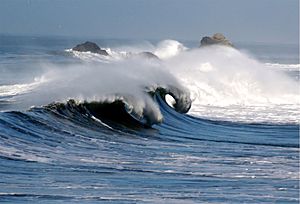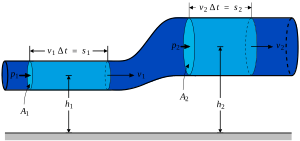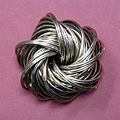
Simulating and calculating the dispersion and
refraction of water waves is one use for the equations.
| Mechanics |

| Rheology |
Viscoelasticity
Smart fluids:
Magnetorheological
Electrorheological
Ferrofluids
Rheometry · Rheometer |
|
|
The Navier–Stokes equations are mathematical equations that describe the motion of fluids. The equations are named after Claude-Louis Navier and George Gabriel Stokes. The equations happen when you apply Newton's second law to fluid dynamics with the guess that the stress, or internal forces, comes from the sum of a diffusing viscous term (based on which way the velocity is changing), plus a pressure term.
They are very useful because many important things flow. Scientists and engineers use the equations in mathematical models of weather, ocean currents, water flow in a pipe, how air flows around a wing, and how stars move inside a galaxy. The Navier–Stokes equations in their full and simplified forms help with the design of aircraft and cars, the study of blood flow, the design of power stations, the analysis of pollution, and many other things. Together with Maxwell's equations (the equations for electricity and magnetism) they can be used to model and study how things that can flow and conduct electricity can produce (and react to) magnetic fields.
The Navier–Stokes equations are also of great interest in a purely mathematical sense. Somewhat surprisingly, given how useful these equations are, mathematicians have not yet proven that in three dimensions solutions always exist, or that if they do exist, then they do not contain any bad points where they become infinite. These are called the Navier–Stokes existence and smoothness problems. The Clay Mathematics Institute has called this one of the seven most important open problems in mathematics, and offered a US$1,000,000 prize (approx. €0.7M or £0.6M as of September 2009) for a solution or a counter-example.
The Navier–Stokes equations dictate not position but rather velocity (how fast the fluid is going and where it is going). A solution of the Navier–Stokes equations is called a velocity field or flow field, which is a description of the velocity of the fluid at a given point in space and time. Once the velocity field is solved for, other quantities of interest (such as flow rate or drag force) may be found. This is different from what one normally sees in classical mechanics, where solutions are typically paths of a particle over time. Studying velocity instead of position makes more sense for a fluid, but for visualization purposes one also can compute various paths that a particle could flow along.
Images for kids
-
Wire model of flow lines along a Hopf fibration.
See also
 In Spanish: Ecuaciones de Navier-Stokes para niños
In Spanish: Ecuaciones de Navier-Stokes para niños


 In Spanish: Ecuaciones de Navier-Stokes para niños
In Spanish: Ecuaciones de Navier-Stokes para niños

